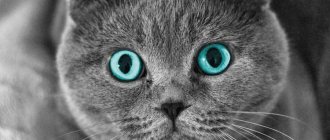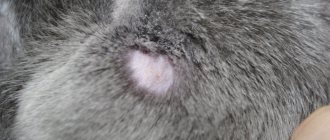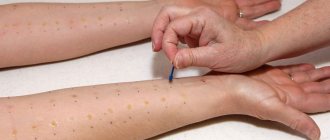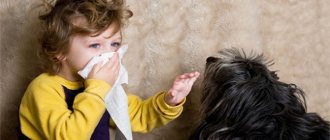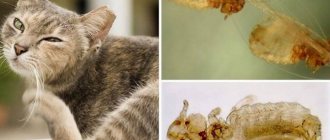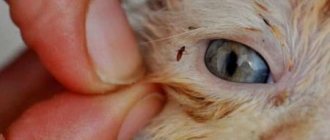What will you learn from the article?
- Types of allergies in cats
- Symptoms How does a cat's food allergy manifest itself?
- Why allergies are dangerous
- Medicines prescribed for allergies
- Ready-made feed
Allergies in cats are a common pathology that can occur in animals of all breeds and mongrel pets. Diseases develop as a result of a malfunction of the immune system. It manifests itself as an increase in sensitivity to completely harmless allergen substances. The immune system of a sick cat begins to perceive these substances as dangerous and turns on a mechanism to combat them.
What types of allergies occur in cats, what the clinical picture of the disease looks like, how the pathology is treated, what methods of prevention exist - we will answer all these questions in this article.
Types of allergies in cats
Allergies are classified according to the type of allergen substance:
- Insect allergy is a reaction to insects (fleas, lice, ticks, lice eaters, mosquitoes, midges, horse flies, wasps, bees). Most often it occurs due to bites of blood-sucking insects. There are reactions to stings (wasps, hornets, bees, bumblebees), to contact (without a bite) and inhalation of insect particles.
- Food allergy is a reaction to food. Most often, allergic reactions occur to beef, chicken, eggs, canned food, fish, cereals and milk. This is the most common type of allergic reaction. Differs in complex diagnostics. There are allergies to cheap food and ready-made food containing grains.
To avoid food allergies to food and products, read the basic rules for feeding kittens.
- Respiratory (breathing) allergy is a reaction to inhalation of plant pollen, fluff, waste products of dust mites, dust, wool, mold spores.
- Contact allergy (dermatitis) is a reaction to contact with irritating substances, for example, detergents, various chemicals, dust, feathers, mold, synthetics, pollen, rubber. This type of allergy may be seasonal.
- Infectious – a reaction to viruses, bacteria and parasites. Allergens are pathogens.
- Medicinal – allergies to medications. It has a cumulative effect. Pathogens: antibiotics, analgesics, vitamins, vaccines.
- Autoimmune. In this type of allergy, the causative agent is the cat’s cell tissue. The immune system fights the cells of the cat's body, perceiving them as foreign.
What is an allergy and an allergen?
To properly deal with allergies in cats, you need to understand what they are.
Allergies in cats must be treated.
Let's understand the terms:
- An allergy is a special reaction of the body's immune system to irritants (allergens), which can be anything.
- An allergen is an antigen that can provoke a hypersensitivity reaction in certain organisms to a specific irritant due to the influence of immunoglobulin.
When an allergen enters a cat’s body, it is not immediately eliminated from the body and this provokes an inflammatory process. The immune system begins to produce histamine, which triggers the onset of allergic reactions.
Symptoms
The symptoms of allergies in cats are reminiscent of some skin diseases, viral pathologies and parasitic diseases. The final diagnosis can only be made in a clinical setting, after a series of diagnostic measures.
Insect allergy is manifested by the appearance of papules (rashes in the form of nodules), scratches and bites, scabs on the animal’s body, as well as intense itching.
Symptoms of food allergies: itching, especially in the eyes, ears and neck of the animal, hair loss, foul odor from the mouth, rash, tearing. It is possible that the cat will vomit white foam and have diarrhea.
Respiratory allergies can manifest as a rash on the animal's body, especially on the head and neck, often with intense itching. Sneezing, watery nasal discharge, and wheezing may also indicate a respiratory allergy. In rare cases, bronchial asthma and suffocation may occur.
Contact dermatitis manifests itself as itching and rashes of various types, including blisters. It is especially pronounced in places that are poorly protected by fur, namely the chin, ears, lower abdomen, and around the anus. The skin becomes red, inflamed, and may become inflamed.
Infectious allergies are diagnosed if a cat has a primary pathology of an infectious nature.
A medicinal type of pathology is indicated by urticaria on the animal’s face. Usually these rashes have clear outlines.
In autoimmune pathology, damage occurs to the skin and mucous tissues. The animal suffers from immune dermatitis. Diagnosis of connective tissue diseases is possible.
How does a cat's food allergy manifest?
Allergies to food are detected in 10-15% of cases of all allergic reactions in cats. This is a fairly high percentage, so every owner should know the main signs indicating a food allergy:
- severe itching - the cat is constantly itching;
- bloody scratches on the pet’s skin, most often on the neck, head, ears;
- hair loss in areas of scratching;
- ulcers and papules on the skin;
- watery eyes;
- swelling of the eyelids;
- snoring due to swelling of the mucous membrane;
- wheezing;
- sneezing, coughing;
- thirst;
- frequent inflammatory diseases of the ears;
- white or gray coating on the tongue;
- unpleasant odor from the mouth;
- increase in body temperature by 1-2 °C.
Why allergies are dangerous
Allergies are a fairly serious disease that not only causes discomfort to your pet, but also has an extremely negative impact on their overall health. Complications of the pathology are extremely serious - anaphylactic shock and death of the animal. Therefore, if you suspect an allergy in your cat, do not hesitate and consult a veterinarian.
List of medications for food allergies
Many animal lovers are interested in how to treat allergies in cats and what medications are needed. It should be noted that in emergency cases, human allergy medications, such as Zinerit, Tavegil, etc., can also help the animal. However, the veterinarian will consider the nature of the cat’s allergies before prescribing the necessary medication.
powerful anti-allergy medicine
The most commonly prescribed medications for cats are:
- Diphenhydramine is a strong antihistamine that has a sedative effect.
- Diphenhydramine is an antihistamine prescribed for severe and frequent vomiting. It is quickly absorbed into the blood, due to which the effect occurs quickly. The drug is withdrawn without complications.
- Pipolzin is an antihistamine for skin lesions (relieves symptoms, but does not cure).
- Chlorpheniramine is a potent broad-spectrum antihistamine.
Less commonly used are drugs such as: Hydroxyzine, Clemastine, Tavegil, Cyproheptadine.
To treat a cat's skin after an allergic reaction, hydrocortisone or dioxidine ointment is used.
Important! It should be remembered that these drugs in large doses can harm pets, so be sure to consult a doctor about the dosage.
Diagnostics
It is not possible to make an accurate diagnosis on your own - diagnostics are carried out only in a veterinary clinic.
This is due to the fact that first of all it is necessary to exclude pathologies that have a clinical picture similar to allergies. There are a lot of such diseases: conjunctivitis, rhinotracheitis, lichen, eczema, dermatitis, etc.
Measures for diagnosing allergies in a cat:
- study of anamnesis;
- tests for worms and external parasites;
- clinical blood test;
- bacteriological culture;
- examination of skin scrapings;
- consultation with a dermatologist;
- trichoscopy;
- biopsy;
- allergy tests.
As soon as the doctor has negative tests for diseases with a clinical picture similar to allergies, the veterinarian begins to gradually eliminate all possible allergens. This process continues until the source of the allergic reaction is determined.
The first step is to identify endo- and ectoparasites.
The second is to transfer the animal to diagnostic nutrition in order to identify or exclude food allergies. This type of pathology is most widespread, so almost all animals are prescribed a special diet.
The cat is fed according to a certain scheme for 1.5-2 months. Over the course of several days, she is given a monomenu containing the suspected allergen product. At this time, she is observed, identifying the cat’s reaction. Then this product is excluded from the diet and another suspected allergen is introduced. All data is recorded. When an allergenic product is identified, it is excluded from the cat’s diet for life.
Other types of allergic reactions can be identified by carefully studying the history. This is how allergies to pollen, insect bites, and pollen are detected.
It will go away on its own
It happens that an allergic reaction to cats disappears over time on its own. The immune system seems to “get used” to the allergen and ceases to consider it dangerous. But, alas, such a happy outcome is relatively rare - it occurs in approximately 20% of allergy sufferers. The rest will have to either part with their pet or take medication for life.
Allergen-specific immunotherapy (ASIT), which gradually “accustoms” the body to the allergen and is successfully used, for example, to treat hay fever, is not yet used for the treatment of cat allergies in Russia. However, the ASIT vaccine against cat allergies is undergoing registration in the Russian Federation. That is, it is a matter of time.
Treatment of allergies in cats
A set of treatment measures is prescribed only after diagnosis and includes:
- Avoiding contact with an allergenic substance.
- Anti-allergenic diet.
- Therapy aimed at eliminating the symptoms of the disease.
Insect allergies are treated by removing fleas, lice, lice, mites on your pet’s body and in the surrounding area (furniture, carpets, sleeping area, etc.). At the same time, anthelmintic treatment of the animal is carried out.
Treating food allergies involves feeding your cat food that does not contain the allergens that cause the animal's reaction.
With respiratory allergies, it is very important to find out what is causing the unpleasant symptoms and get rid of it as soon as possible. For example, if an animal is allergic to pollen, then you should not open windows during the period of active flowering of plants. It is necessary to carry out wet cleaning in the room more often and more thoroughly.
Treatment of contact allergies primarily involves identifying and eliminating the allergen.
An infectious allergy goes away after the virus that caused it is suppressed. Additionally, the animal is given antihistamines and drugs to strengthen the immune system.
Drug allergies require complete exclusion of the use of the identified allergen drug. To do this, a note is made in the cat’s veterinary passport. If necessary, antishock therapy is prescribed.
If an autoimmune pathology is detected, hormonal therapy is prescribed. The cat is administered glucocorticosteroids according to a specific regimen. In parallel, measures are taken to suppress the function of the immune system.
In addition to specific treatment measures, your doctor may recommend the following treatments to help relieve your pet's condition, especially if itching is severe:
- bathing with medicated shampoo, which contains anti-inflammatory components;
- steroids and antihistamines - these medications (in the form of injections or ointments) sharply block allergic reactions, which almost immediately alleviates the animal’s condition with severe itching and skin irritation;
- antibiotics - the animal can scratch the rash on the skin, and a bacterial infection or fungal skin lesions are added to the allergy.
Medicines prescribed for allergies
- Antihistamines.
- Immunostimulants.
- Corticosteroids.
Important!
It is unacceptable to give your cat medications unless they are prescribed by a veterinarian.
Pets that do not cause allergies
| Cats | ||
| cat breeds that do not cause allergies | ||
| Balinese breed | Cats of this breed produce the least amount of allergen protein, so Balinese are one of the most non-allergic cats. | |
| Oriental (Eastern) Shorthair | Good grooming - brushing the short coat and regular bathing will reduce the risk of allergic reactions to a minimum. | |
| Javanese (Javanese) | Due to the absence of undercoat, the wool does not mat and retains less allergen. | |
| Devon Rex | The Devon Rex has short and sparse fur. They are easy to care for - they need to regularly clean their ears and paw pads of accumulated secretions, but do not need to be bathed as often as Sphynx cats. | |
| Cornish Rex | This breed needs to be washed regularly to cleanse its skin of secretions. | |
| Sphinx | These cats, indeed, most often do not cause allergies. However, Sphynx cats are quite difficult to care for. Your cat needs frequent bathing to remove sticky secretions from the skin. | |
| Siberian breed | Siberian cats have quite long and fluffy hair, but their amount of allergenic enzyme is very low. It is believed that up to 75% of allergy sufferers are not allergic to this breed. | |
| Dogs | ||
| dog breeds that do not cause allergies | ||
| Chinese Crested | This breed does not shed because either has no fur at all, or may have some on the paws, tail and head. There is no smell. | |
| American Hairless Terrier | There is no hair on their body at all. The skin does not peel off, which means skin flakes can be excluded from the list of possible allergens. | |
| Mexican hairless dog | Completely hairless and odorless. | |
| Giant Schnauzer | This breed has a short coat of hard guard hairs, so it hardly sheds. After the undercoat falls out, it remains under the hard top coat. Therefore, the dog must be periodically combed (once a week) and cut (once every couple of months). | |
| Yorkshire Terrier | Wool resembles the structure of human hair. They don't shed. With short haircuts, they only need to be thoroughly brushed occasionally (1-2 times a week). | |
| Poodle | Shedding occurs once in a lifetime - at about 8 months of age. | |
| Samoyed | The coat is very hard and thick. Molting would disrupt its most important function, so loss of fur in a Samoyed is possible only due to illness. | |
| Bolognese | Although it has thick and long hair, it does not shed. | |
| Bichon Frize | This breed needs to be trimmed regularly as it has long hair. Has no undercoat. Doesn't shed. | |
| Affenpinscher | Has long hair and does not shed. Thanks to regular care, there is no unpleasant odor from it. | |
| Whippet | Hypoallergenic breed. It is smooth-haired with short hair, in addition, it is renewed so slowly that shedding remains unnoticed. Sometimes a whippet needs to be brushed to maintain a beautiful and well-groomed appearance. | |
| Irish Water Spaniel | It practically does not lose hair and has reduced salivation, which is very suitable for allergy sufferers. He needs to be given periodic haircuts and combing. | |
Feeding a cat with allergies
A special diet is an obligatory part of a complex of therapeutic measures.
Ready-made feed
Cats that receive industrial food are switched to hypoallergenic brands of food:
- 1st Choice Cat Adult Hypoallergenic Duck Grain Free is a dry food for adult animals with allergies to duck meat. Has a grain-free composition. The main source of vegetable protein and carbohydrates is sweet potato. Contains flax seed and salmon oil (Omega-3 and Omega-6). Enriched with vitamins and minerals. A package of food (2.72 kg) can be purchased for 1,660 rubles/870 UAH.
- Grandorf Adult Cat Sterilized Rabbit & Rice Hypoallergenic - food for sterilized animals suffering from allergies to rabbit, turkey and rice. The food helps control the weight of cats prone to obesity. Suitable for older animals. The food contains no allergenic products. The low grain formula is enriched with natural antioxidants, L-carnitine, brewer's yeast and chicory. A pack (2 kg) costs 1400 rubles/850 UAH.
- Optima Nova Adult Cat Rabbit & Potato Grain Free, Hypoallergenic – food for adult animals with allergies based on rabbit meat (75%) and potatoes. Completely grain-free formula. Holistic. Does not contain GMOs. Enriched with prebiotics, Omega-3, Omega-6. A pack of food (2 kg) can be purchased for 2000 rubles/950 UAH.
- Brit Veterinary Diet Cat Grain Hypoallergenic is a dietary hypoallergenic dry food on a grain-free basis. Monoprotein formula with salmon meat. Does not contain soy. Enriched with Omega-3, biotin, vitamins and minerals. Sea buckthorn is a natural antioxidant. A pack (2 kg) costs 1205 rubles/640 UAH.
- Royal Canin (2.5 kg) Hypoallergenic DR25 is a veterinary formula of budget food for cats with allergies. The food contains grains. Enriched with FOS and fish oil. A package of food (2.5 kg) costs 1950 rubles/850 UAH.
Natural nutrition
When an allergenic product is identified, it is completely excluded from the pet’s menu. The cat's diet consists of hypoallergenic foods:
- turkey;
- lamb;
- rabbit;
- Brown rice;
- zucchini;
- buckwheat;
- broccoli;
- squash.
The diagnosis will be made by a specialist
If such a disease can be diagnosed in a person by studying allergy tests, then for representatives of the cat family this method is considered ineffective. The procedure for a cat is carried out under general anesthesia, since about two dozen allergens need to be introduced. But anesthesia reacts with test allergens, distorting the reaction. As a result, a false local reaction occurs. Complex and expensive analysis becomes uninformative. Test kits intended for humans are not suitable for our mustachioed friends. There is no alternative; medications of this type have not been developed for allergic cats.
To find out exactly what a cat is allergic to, they use the elimination method. All potentially dangerous substances are removed from the environment, then they are returned, observing the body's reaction. If this is a seasonal disease, it is not necessary to accurately identify the allergen. During this time, the cat is prescribed medications that eliminate the effects of the dangerous substance and relieve symptoms.
Similar reactions occur in cats after surgery (castration, sterilization, solving other problems), as well as after vaccination. Symptoms usually go away soon, but treatment will be needed to alleviate the cat's condition. The veterinarian will determine whether the symptoms are caused by an allergy to the medication. In the future, this will allow you to select a safe analogue.
Allergy prevention
To help your cat, you must provide:
- regular and thorough cleaning of the room where your pet lives;
- keep substances that may cause allergies out of reach;
- feed your animal only proven high-quality food, taking into account the breed, physiological characteristics and lifestyle of your pet;
- use stainless steel or ceramic dishes as a feeder;
- Regularly treat your pet for fleas and ticks.


